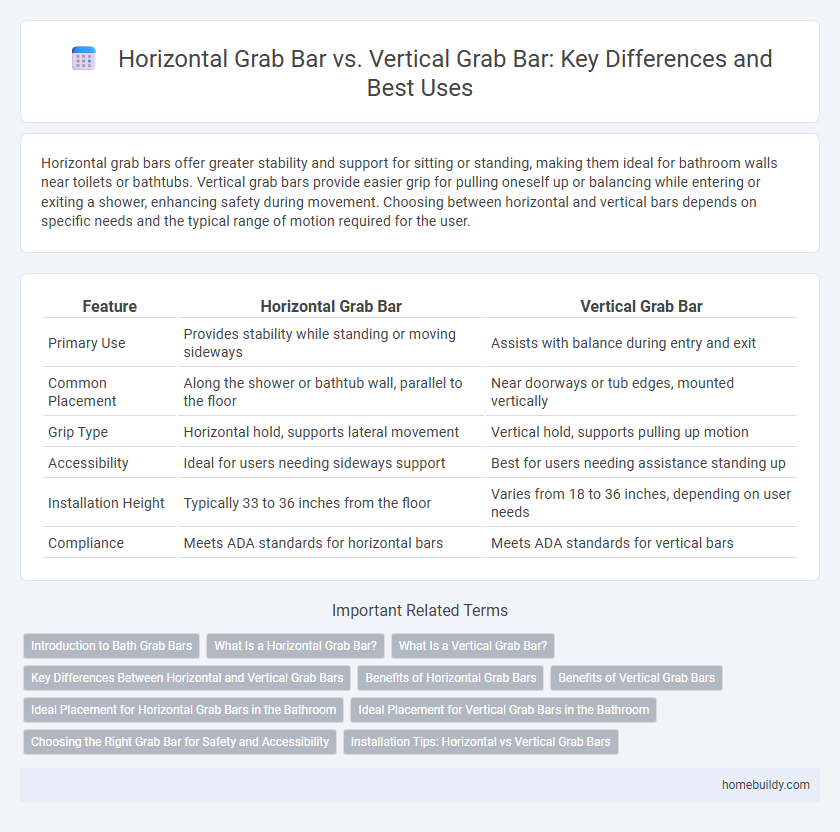Horizontal grab bars offer greater stability and support for sitting or standing, making them ideal for bathroom walls near toilets or bathtubs. Vertical grab bars provide easier grip for pulling oneself up or balancing while entering or exiting a shower, enhancing safety during movement. Choosing between horizontal and vertical bars depends on specific needs and the typical range of motion required for the user.
Table of Comparison
| Feature | Horizontal Grab Bar | Vertical Grab Bar |
|---|---|---|
| Primary Use | Provides stability while standing or moving sideways | Assists with balance during entry and exit |
| Common Placement | Along the shower or bathtub wall, parallel to the floor | Near doorways or tub edges, mounted vertically |
| Grip Type | Horizontal hold, supports lateral movement | Vertical hold, supports pulling up motion |
| Accessibility | Ideal for users needing sideways support | Best for users needing assistance standing up |
| Installation Height | Typically 33 to 36 inches from the floor | Varies from 18 to 36 inches, depending on user needs |
| Compliance | Meets ADA standards for horizontal bars | Meets ADA standards for vertical bars |
Introduction to Bath Grab Bars
Bath grab bars enhance safety and prevent falls in wet environments by providing stable handholds. Horizontal grab bars offer extended support along the bathtub or shower wall, facilitating balance when entering or exiting. Vertical grab bars assist with lifting and lowering motions, making them ideal for maneuvering into seated positions.
What Is a Horizontal Grab Bar?
A horizontal grab bar is a safety device installed parallel to the floor, commonly found in bathrooms to provide stability and support while standing or moving. Unlike vertical grab bars, which offer assistance in pulling up or steadying from a seated position, horizontal bars enhance balance by allowing users to grip along a longer, consistent surface. These bars are essential in preventing slips and falls, especially near bathtubs and showers.
What Is a Vertical Grab Bar?
A vertical grab bar is a safety fixture mounted perpendicular to the floor, providing support for users when standing up or sitting down in the bath or shower area. This type of grab bar improves stability by offering an easy-to-grip surface that helps prevent slips and falls, especially for individuals with limited mobility. Compared to horizontal grab bars, vertical bars are ideal for assisting with balance and vertical lifts rather than lateral movement.
Key Differences Between Horizontal and Vertical Grab Bars
Horizontal grab bars provide greater stability and support along a wider range of motion, typically installed near bathtubs or shower walls to aid in balance while standing or moving laterally. Vertical grab bars offer enhanced leverage and assistance when pulling oneself up from a seated or low position, commonly placed near toilets or at shower entrances for upright support. The key difference lies in their orientation and function: horizontal bars facilitate horizontal movement and balance, whereas vertical bars primarily assist with vertical lifting and posture control.
Benefits of Horizontal Grab Bars
Horizontal grab bars provide superior stability and support during transfers and movement along walls, reducing the risk of slips and falls in the bathroom. Their extended length allows for a firm handhold at various positions, accommodating different user heights and grips for enhanced safety. These bars are especially effective for assistance in sitting down and standing up from the toilet or bathtub.
Benefits of Vertical Grab Bars
Vertical grab bars enhance stability by providing multiple gripping points and support for users as they transition between sitting and standing. Their orientation allows for easier reach and better leverage, which is especially beneficial for those with limited upper body strength or mobility issues. Vertical bars also offer increased safety in narrow spaces, such as beside toilets or showers, where horizontal bars may not fit effectively.
Ideal Placement for Horizontal Grab Bars in the Bathroom
Ideal placement for horizontal grab bars in the bathroom is typically along the shower wall between 33 to 36 inches from the floor, providing stable support while entering and exiting the tub or shower. Positioning the bar near the bathtub's edge enhances safety during bath transfers and minimizes slip risks. Installing horizontal grab bars at this height accommodates a wide range of users, ensuring optimal leverage and balance.
Ideal Placement for Vertical Grab Bars in the Bathroom
Vertical grab bars in the bathroom are ideally placed near the toilet and shower entrance to provide secure support for users during standing and sitting movements. Positioning the bar between 33 to 36 inches above the floor ensures optimal reach and stability. Installing vertical grab bars adjacent to horizontal ones enhances overall safety by accommodating varied grip preferences and body mechanics.
Choosing the Right Grab Bar for Safety and Accessibility
Horizontal grab bars provide stable support during movement along walls and are ideal for bathrooms or showers where users need consistent balance assistance. Vertical grab bars offer crucial aid for entering or exiting bathtubs, providing a secure handhold that helps users pull themselves up or lower down safely. Selecting the right grab bar depends on mobility needs, bathroom layout, and positioning for optimal safety and enhanced accessibility.
Installation Tips: Horizontal vs Vertical Grab Bars
When installing bath grab bars, horizontal bars provide greater stability for users to sit or stand by offering extended arm support, while vertical bars assist more with balance when entering or exiting the tub. Ensure horizontal grab bars are installed at a height between 33 to 36 inches from the floor to maximize grip comfort, and vertical bars should be placed near the tub edge at about 18 inches above the floor for optimal reach. Use wall studs or a solid backing to securely anchor both types to support at least 250 pounds of weight for safety and durability.
horizontal grab bar vs vertical grab bar Infographic

 homebuildy.com
homebuildy.com